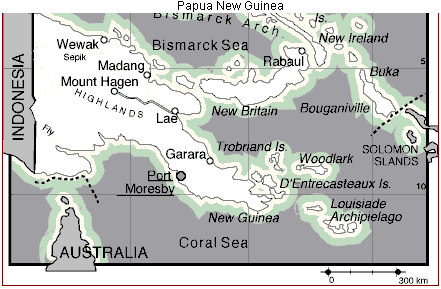
Return to * Top Ten *RIC Main Page * Background Info
Papua New Guinea
Background Information

Basic Indicators
| Population | 4.205 million |
| Population growth | 2.31% |
| Land area | 452860 sq km |
| Life Expectancy | 67 years |
| GNP per capita | 1240 current us$ |
| Literacy | 72% |
ENVIRONMENT
Located east of Indonesia, just south of the Equator, the country is made up of the eastern portion of the island of New Guinea (the western part is the Indonesian territory of Irian Jaya) plus a series of smaller islands; New Britain, New Ireland and Manus, in the Bismarck archipelago; Bougainville, Buka and Nissau, which form the northern part of the Solomon Islands; the Louisiade and Entrecasteaux archipelagos; and the islands of Trobriand and Woodlark, southeast of New Guinea. The terrain is volcanic and mountainous, except for the narrow coastal plains. The climate is tropical and the vegetation is equatorial rain forest. The country suffers from deforestation, due to large-scale indiscriminate felling.
SOCIETY
Peoples: The inhabitants are mostly Melanesian. There are Micronesian, Polynesian and "Negritoid" groups (the latter being an ethnic group from the Malaysian archipelago). There are 40,000 inhabitants of European descent, mostly Australians. Religions: Many people practise local traditional religions but they also belong to Catholic and Protestant communities. Languages: English (official). A local Pidgin, with many English words and Melanesian grammar is widely spoken, as well as 700 other local languages. Political Parties: Popular Democratic Movement (PDM); Pangu Pati (PP); Popular Action Party; Popular Progressive Party (PPP).
THE STATE
Official Name: Independent State of Papua New Guinea. Administrative Divisions: 20 Provinces. Capital: Port Moresby, 200,000 inhab. (1990). Other cities: Lae, 80,655 inhab.; Madang, 27,057 inhab.; Wewak, 23,224 inhab.; Goroka, 17,855 inhab. (1990). Government: Queen Elizabeth II of the United Kingdom, Head of State, represented by a Governor General. Julius Chan, Prime Minister and Head of the Government. Single-chamber legislature: Parliament, with 109 members. National Holiday: September 16, Independence Day (1975). Armed Forces: 3,800 troops (1995).
Source: World Guide 1997/98 courtesy of New Internationalist ![]()
Return to * Top Ten *RIC Main Page * Background Info